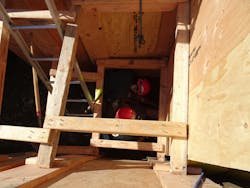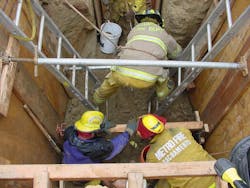Technical Rescue: First-Line Tactical Priorities for Trench Rescue
When we discuss or train in the area of trench rescue operations, we often focus on complex equipment or difficult-to-interpret tabulated data regarding the dynamics of soil weights, soil pressures and protective systems. Although those things are important, we can neglect to commit the time and effort to properly cover first-line tactical priorities and simple concepts that set an incident on a successful trajectory. Reviews of post-incident critiques of trench rescues (and other technical rescue incidents) reveal that simple and effective decisions that are made early in the incident ultimately result in more positive things happening. Conversely, a misstep early in the incident results in confusion snowballs that grow as they roll downhill. In these circumstances, we spend precious time trying to recover from bad decisions.
Risk-vs.-gain analysis
Numerous management techniques and equations are utilized for managing incidents (e.g., CRM: Crew Resource Management, and ERO: Event + Response = Outcome). Regardless, you must determine a survival profile of the victim(s). This risk-vs.-gain analysis must be completed to ensure that you don’t waste time and risk lives for nothing. For example, if factors lead to the belief that the situation is a body recovery and this can be confirmed based on conditions, then rescuers must slow things down and move forward in a manner that doesn’t risk their life. This might include waiting for additional equipment, such as trench shields, and removing spoil (dirt) remotely.
Here, let me get specific: Imagine that you just stepped out of the rig on a construction site and that it appears that you are confronted with a trench rescue incident. The philosophical discussion about “tactical priorities” is over, and you must get moving in the right direction, making decisions and asking questions that will help you to determine survival profile, to protect the victim(s) and rescuers, and to prepare for technical operations that are defendable based on the trenching and excavation regulations that apply to your operation.
At this point, you’d like to get at least two things happening at once: locating a responsible party to ask critical questions regarding the incident; and completing the first four tactical priorities (see below). If you arrive with a crew of two or three (including yourself), you can achieve this objective.
Questioning the responsible party
When considering the responsible party, I encourage you to evaluate them and their answers less like a firefighter and more like a law enforcement officer.
When we arrive at routine incidents, we arrive attempting to help or protect all of those who are involved, seeking information to provide treatment, care, etc. When members of law enforcement arrive at a routine incident, they often look for parties who are responsible for a crime and assume that most everyone who they encounter is lying to them or attempting to deceive them. We must recognize that in regard to trench rescues, the responsible parties might deceive in an effort to protect themselves from liability or that their answers might be unreliable based on the confusion or shock of the current event.
It’s wise to ask the responsible party your questions, ensure that they remain on site, and then return to ask them some or all of the questions again. If the answers are different, you determined that the individual is unreliable. It doesn’t matter why.
Critical questions to ask include: How many personnel were working in the trench? Where were the workers last seen? How long have they been trapped in the collapse? Was an underground service alert reported before excavation of the trench began? Were all utilities located? What type of work were workers doing? (New trench? Repair work?) This last question might seem unimportant, but new trenches in virgin soil normally result in more predictable soil performance than previously disturbed soil in repair work conditions.
It also is vital for rescuers to know how deep workers were digging. Although this question might seem rudimentary, knowing this keeps rescuers from digging deeper than the original depth when looking for victims. It helps to determine where to focus attention: You can calculate where there is and isn’t enough collapsed spoil to hide a victim. It also assists in evaluating material needs based on the ultimate shoring depth that’s expected.
First four tactical priorities
Designate a safety officer. This position initially may be held by the first-arriving officer who also is serving as the incident commander and operations officer. Later, the position should be assigned to someone who is trench-rescue-operations trained.
Assigning this position from beginning of the response to the end assists in complying with other regulatory issues, such as fall protection, etc.
Get ladders into the trench. Trenching regulations require rescuers to provide egress for workers in the trench whenever the trench is at least four feet deep. Initially, the ladders that are placed in the trench aren’t for the benefit of the victim(s); they are for any rescuer who is working the edge who might inadvertently fall into the trench.
Ultimately, ladders will be used by the rescuers who are in the trench. At that time, workers always should be able to reach a ladder within 25 feet. Furthermore, the ladders must be secured and be long enough to reach at least three feet above the lip of the trench.
Clear spoil. Any spoil on the edge, or lip, of the trench creates a surcharge load on the lip, which increases the possibility of further collapse. It also creates an uneven and difficult surface to stand on or operate from while supporting activities in the trench. This spoil must be moved, and it must be moved by hand to reduce further vibration on the lip.
The minimum clear area on the lip should be two feet. When personnel clear spoil, they should be reminded to not work with their back to the trench, because this increases the possibility of accidental falls.
Provide edge protection on the lip of the trench. The material that’s used to provide edge protection can be just about anything. The objective of the effort is to distribute the weight of those who are working the edge over a wider area, to reduce the chance of a trench lip failure.
Personnel who clear spoil should be reminded that they should stand on edge protection. Not only does this safety practice prevent a secondary collapse, but it also provides a cleaner and more stable surface from which to work.
Mind OSHA
None of the aforementioned priorities takes specialized skills or equipment. Thus, not only can the first-line tactical priorities be completed by the first-arriving company, but they should be completed by that crew. If technical rescue units arrive to find that these priorities are completed or well underway, they can focus on shoring strategies and other priorities.
Unfortunately, many times, first-arriving companies do practically nothing as they wait for technical rescue resources to arrive. More often than not, that’s because they are unsure of what to do. In the cases in which they do act, they place themselves at risk by entering the trench without appropriate protection.
All personnel should be reminded that, statistically, once there was a trench collapse, there’s a 60 percent chance that there’ll be a secondary collapse. For this reason—as well as the fact that collapsing dirt is nondiscriminatory about who it collapses on—Occupational Safety and Health Administration trenching and excavation regulations apply to rescuers as well as construction operations. You would be wise to remind yourself that the regulation clearly requires that personnel who work in trenches must work within appropriate protective systems. Those systems must be determined by the width and depth of the trench and the type of soil, but work only should begin after first-line tactical priorities are completed.
About the Author

Kent Freeman
Kent Freeman is a 30-year veteran of the fire service. He retired from the Roseville, CA, Fire Department, where he served as the coordinator of technical rescue services. Freeman served as the project leader for the Confined Space Rescue Technician program of the California State Fire Training Division (CSFT) and served on the working group for the development of the CSFT’s Trench Rescue Technician program. He remains active in teaching programs for fire departments and private industry.

